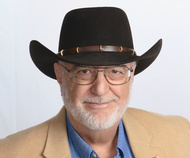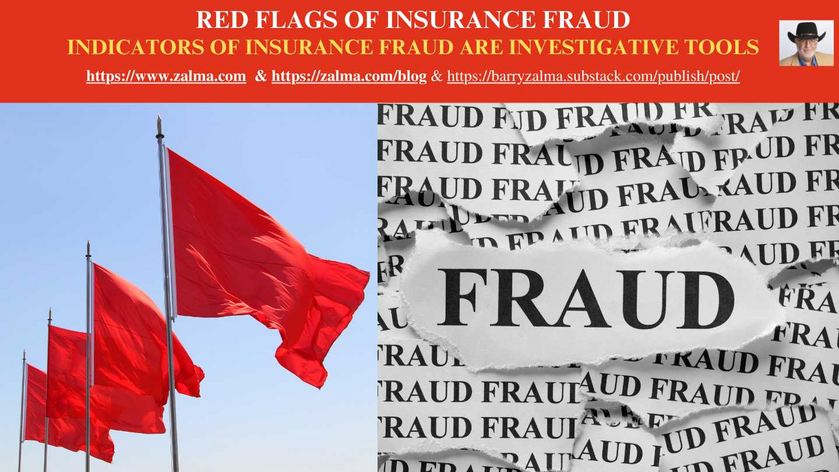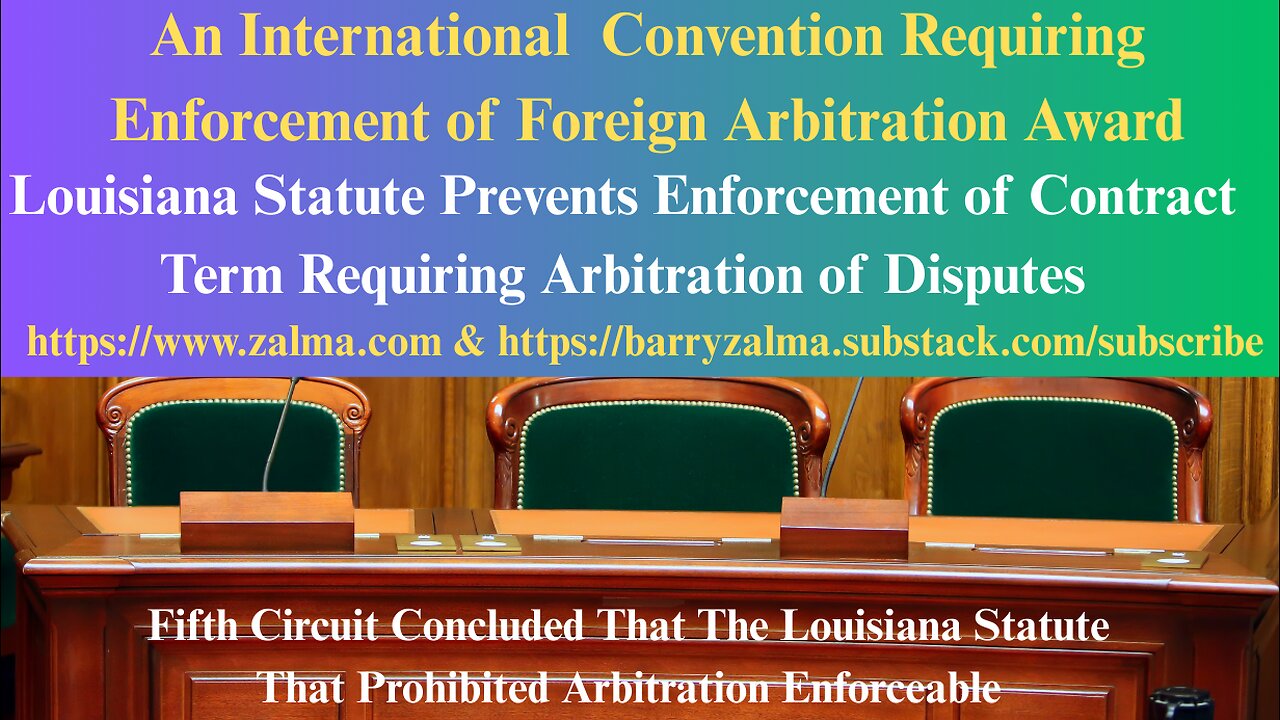
Indicators of Insurance Fraud are Investigative Tools
Barry Zalma
Mar 27, 2024
Read the full article at https://lnkd.in/gvtv9gCz where you can see more red flags, see the full video at https://lnkd.in/gMirVfZc and at https://lnkd.in/g2ndng5r and at https://zalma.com/blog plus more than 4750 posts.
Post 4763
Suspicious claims have common attributes. Insurers and their anti-fraud organizations have collated the common attributes into lists of indicators or red flags of fraud. The lists were created as training aids and to be used to determine whether further investigation is required to determine if a claim is legitimate or false and fraudulent. Continually growing, these lists are known as the “red flags” or “indicators” of fraud lists. There are many different categories, ranging from those associated with the claim itself or with insureds to indicators of specific types of fraud, such as bodily injury fraud or arson for profit.
If, when assessing a claim, three or more red flags are found the need for further investigation should be considered and evaluated by the claims person, a supervisor and the insurer’s special investigative unit. The existence of red flags does not mean a fraud has occurred. Red flags are only a signal to the adjuster to investigate further so that the suspicion may be either removed or confirmed. It is not any single indicator that alerts the adjuster to the possibility of a fraudulent claim but a combination of the red flag or red flags discovered coupled with the results of the thorough claims investigation.
Although the existence of multiple red flags should trigger an investigation, failure to investigate has been held to be reasonable as long as there are no patent inaccuracies or actual knowledge of false representations.
Although the existence of multiple red flags should trigger an investigation, failure to investigate has been held to be reasonable as long as there are no patent inaccuracies or actual knowledge of false representations.
Red Flags
More than one mortgage,
late payments,
divorce,
prior claims,
multiple claims,
problems affecting title to the property,
over-insurance,
an increase in insurance coverage right before the claim,
recent cancellations of insurance held with prior insurers,
liens,
threats of foreclosure on the property,
lawsuits, and
recent job transfers.
As the Nebraska Department of Insurance states in its booklet, Fraud Detection Hints, it is “important to remember that the … possible ‘red flags’ [indicate] that there may be some evidence consistent with an insurance fraud scheme. Any one or two of these by themselves may not raise your suspicions; however, when you have several of these hints (red flags) present or a pattern begins to emerge, you should investigate further or forward your suspicion to the Insurance Fraud Prevention Division.” [O’Donnell v. Allstate Insurance Co., 734 A.2d 901, 1999 PA Super 161 (Pa. Super., 1999); and LeForge v. Nationwide Mut. Fire Ins. Co., 82 Ohio App. 3d 692 (Ohio App., 1992).]
Red Flags Common to a Claim
An adjuster should consider further investigation if a claim occurs:
shortly after the issuance of the policy;
shortly after the limits of the policy are increased;
in an insured’s first insurance;
shortly before the expiration of a policy;
within days of a notice of cancellation being served; or
on a policy acquired from an agent far from the insured’s home or business
Red Flags Connected with the Insured or Claimant
Adjusters evaluate the manner in which the insured makes a claim. A few red flags that may raise suspicions include some of the following when the insured or claimant:
retains or is represented by counsel on the day of the loss;
does not want to retain counsel;
is represented by a public adjuster on the day of the loss;
wants a settlement approved quickly;
does not want the claim to go to a supervisor, regional office, or claims committee for authority;
is exceedingly cooperative and undemanding;
is exceedingly demanding and threatens a bad faith suit from the date of first contact;
demands a proof of loss form at the initial meeting;
is familiar with insurance claims terminology;
asks for the claims manager by name;
is familiar with the adjuster’s authority limits, and wants to settle for a sum within those limits;
handles all business in person (thus avoiding mail and potential prosecution for violation of federal mail fraud statutes);
provides an address that is a post office box, mail drop, or hotel; or
reduces the demand for settlement when it is suggested by the adjuster that he or she file suit.
The adjuster or investigator should also pay attention to the insured’s or claimant’s history and background, including their financial situation.
Red Flags Concerning the Insured
The insured has lived at his current address less than six months.
The insured has been with current employer less than six months.
The insured has a previous history of losses.
The insured cancels scheduled appointments with the adjuster for statements and/or Examination Under Oath.
The insured is employed with an insurer.
The insured is unusually aggressive and pressures for a quick settlement.
The insured does not have a telephone.
The insured’s telephone number is only a mobile cellular phone.
The insured is difficult to contact.
The insured claims to be self-employed but is vague about the business, and his responsibilities.
The insured is very knowledgeable about claims process and Insurance terminology.
The insured offers inducement for a quick settlement.
The insured is unsolicited new, walk-in business, not referred by an existing policyholder.
The insured’s address is not consistent with his employment or income.
The insured only gives a post office box as his address.
The insured is unemployed or in a transient occupation.
The insured seeks a copy of the policy before agreeing to insure.
The insured is vague about loss.
The insured’s report of loss is inconsistent.
The insured has a selective memory.
The insured has financial difficulties.
Fraud by Insurers
Insurers and their officers commit fraud in many ways, including, but not limited to:
Submission of falsified financial statements.
Misuse of company funds.
Issuance of unauthorized insurance policies.
Insurance plans not authorized by the state Departments of Insurance.
Individuals not licensed to do the business of insurance.
Fraudulent group/individual health plans.
Some examples of fraud by insurers claimed under homeowners policies:
Insisting that the insured allow the insurer to generate the loss inventory after a covered loss.
Issuing policies with a declaration page showing policy limits that the insurer knows is higher than the actual cash value or replacement cost of the property, the risk of loss of which is insured, to take premium for a greater risk than that actually taken.
Using economic coercion to force the claimant to use their preferred repair vendor.
Undercutting market rates to lure employers to acquire Workers’ Compensation insurance while failing to properly maintain sufficient funds in reserve to cover claims.
Use of an unqualified or dishonest Medical Examiner to avoid payment of claims.
Use of unethical defense attorneys to avoid payments of claims.
Use of unethical private investigators.
Use of Special Investigative Unit investigators whose only purpose is to deny claims rather than in an effort to avoid fraud.
ZALMA OPINION
Red flags are not evidence. They are often contradictory. They are evidence that a fraud might be happening and require, when more than three or four red flags show up in an investigation that it is time to refer the claim to the insurer’s Special Investigative Unit to determine if there exists admissible evidence that a fraud has been attempted.
(c) 2024 Barry Zalma & ClaimSchool, Inc.
Please tell your friends and colleagues about this blog and the videos and let them subscribe to the blog and the videos.
Subscribe to my substack at https://barryzalma.substack.com/publish/post/107007808
Go to X @bzalma; Go to Newsbreak.com https://www.newsbreak.com/@c/1653419?s=01; Go to Barry Zalma videos at Rumble.com at https://rumble.com/c/c-262921; Go to Barry Zalma on YouTube- https://www.youtube.com/channel/UCysiZklEtxZsSF9DfC0Expg.
Go to the Insurance Claims Library – https://lnkd.in/gwEYk

Detail Charging Defendant for Fraud is Sufficient
Post 5242
Read the full article at https://lnkd.in/g_HVw36q, see the video at https://lnkd.in/gpBd-XTg and at https://lnkd.in/gzCnBjgQ and at https://zalma.com/blog plus more than 5200 posts.
Charges that Advises the Defendant of the Crime Cannot be Set Aside
In United States Of America v. Lourdes Navarro, AKA Lulu, No. 25-661, United States Court of Appeals, Ninth Circuit (December 4, 2025) Lourdes Navarro appealed the district court’s denial of her motion to dismiss the indictment and enter final judgment was in error.
FACTUAL BACKGROUND
The indictment alleged that insurers reimburse only for medically necessary services. Navarro performed unnecessary respiratory pathogen panel (RPP) tests on nasal swabs collected from asymptomatic individuals for COVID-19 screening.
Navarro billed over $455 million to insurers for those additional RPP tests that she knew to be medically unnecessary. These allegations constituted a plain, concise, and definite written ...
Louisiana Statute Prevents Enforcement of Contract Term Requiring Arbitration of Disputes
Post 5241
Read the full article at https://www.linkedin.com/pulse/international-convention-requiring-enforcement-award-barry-sttdc, see the video at and at and at https://zalma.com/blog plus more than 5200 posts.
In Town of Vinton v. Indian Harbor Insurance Company, Nos. 24-30035, 24-30748, 24-30749, 24-30750, 24-30751, 24-30756, 24-30757, United States Court of Appeals, Fifth Circuit (December 8, 2025) municipal entities including the Town of Vinton, et al sued domestic insurers after dismissing foreign insurers with prejudice. The insurers sought arbitration under the Convention on the Recognition and Enforcement of Foreign Arbitral Awards (the “Convention”) but the court held Louisiana law — prohibiting arbitration clauses in such policies—controls, as the Convention does not apply absent foreign parties who ...

Refusal to Provide Workers’ Compensation is Expensive
Post 5240
Read the full article at https://lnkd.in/guC9dnqA, see the video at https://lnkd.in/gVxz-qmk and at https://lnkd.in/gUTAnCZw, and at https://zalma.com/blog plus more than 5200 posts.
In Illinois Department of Insurance, Insurance Compliance Department v.USA Water And Fire Restoration, Inc., And Nicholas Pacella, Individually And As Officer, Nos. 23WC021808, 18INC00228, No. 25IWCC0467, the Illinois Department of Insurance (Petitioner) initiated an investigation after the Injured Workers’ Benefit Fund (IWBF) was added to a pending workers’ compensation claim. The claim alleged a work-related injury during employment with the Respondents who failed to maintain workers’ compensation Insurance.
Company Overview:
USA Water & Fire Restoration, Inc. was incorporated on January 17, 2014, and dissolved on June 14, 2019, for failure to file annual reports and pay franchise taxes. It then operated under assumed names including USA Board Up & Glass Co. and USA Plumbing and Sewer. The business ...
Zalma’s Insurance Fraud Letter
Read the full article at https://lnkd.in/dG829BF6; see the video at https://lnkd.in/dyCggZMZ and at https://lnkd.in/d6a9QdDd.
ZIFL Volume 29, Issue 24
Subscribe to the e-mail Version of ZIFL, it’s Free! https://visitor.r20.constantcontact.com/manage/optin?v=001Gb86hroKqEYVdo-PWnMUkcitKvwMc3HNWiyrn6jw8ERzpnmgU_oNjTrm1U1YGZ7_ay4AZ7_mCLQBKsXokYWFyD_Xo_zMFYUMovVTCgTAs7liC1eR4LsDBrk2zBNDMBPp7Bq0VeAA-SNvk6xgrgl8dNR0BjCMTm_gE7bAycDEHwRXFAoyVjSABkXPPaG2Jb3SEvkeZXRXPDs%3D
Zalma’s Insurance Fraud Letter (ZIFL) continues its 29th year of publication dedicated to those involved in reducing the effect of insurance fraud. ZIFL is published 24 times a year by ClaimSchool and is written by Barry Zalma. It is provided FREE to anyone who visits the site at http://zalma.com/zalmas-insurance-fraud-letter-2/
Zalma’s Insurance Fraud Letter
Merry Christmas & Happy Hannukah
Read the following Articles from the December 15, 2025 issue:
Read the full 19 page issue of ZIFL at ...
The Professional Claims Handler
Post 5219
Posted on October 31, 2025 by Barry Zalma
An Insurance claims professionals should be a person who:
Can read and understand the insurance policies issued by the insurer.
Understands the promises made by the policy.
Understand their obligation, as an insurer’s claims staff, to fulfill the promises made.
Are competent investigators.
Have empathy and recognize the difference between empathy and sympathy.
Understand medicine relating to traumatic injuries and are sufficiently versed in tort law to deal with lawyers as equals.
Understand how to repair damage to real and personal property and the value of the repairs or the property.
Understand how to negotiate a fair and reasonable settlement with the insured that is fair and reasonable to both the insured and the insurer.
How to Create Claims Professionals
To avoid fraudulent claims, claims of breach of contract, bad faith, punitive damages, unresolved losses, and to make a profit, insurers ...

The History Behind the Creation of a Claims Handling Expert
The Insurance Industry Needs to Implement Excellence in Claims Handling or Fail
Post 5210
This is a change from my normal blog postings. It is my attempt. in more than one post, to explain the need for professional claims representatives who comply with the basic custom and practice of the insurance industry. This statement of my philosophy on claims handling starts with my history as a claims adjuster, insurance defense and coverage lawyer and insurance claims handling expert.
My Training to be an Insurance Claims Adjuster
When I was discharged from the US Army in 1967 I was hired as an insurance adjuster trainee by a professional and well respected insurance company. The insurer took a chance on me because I had been an Army Intelligence Investigator for my three years in the military and could use that training and experience to be a basis to become a professional insurance adjuster.
I was initially sat at a desk reading a text-book on insurance ...














